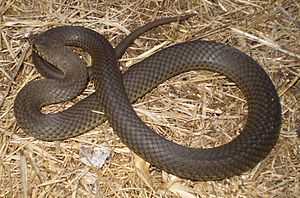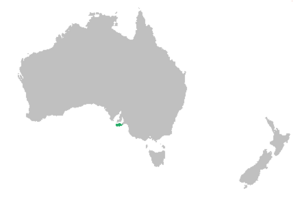Pygmy copperhead facts for kids
Quick facts for kids Pygmy copperhead |
|
|---|---|
 |
|
| Conservation status | |
| Scientific classification | |
| Genus: |
Austrelaps
|
| Species: |
labialis
|
 |
|
| Distribution (in green; click to enlarge) | |
| Synonyms | |
|
Alecto labialis Jan, 1859 |
|
The pygmy copperhead (Austrelaps labialis) is a type of venomous snake found in Australia. It lives on Kangaroo Island and the Fleurieu Peninsula in South Australia. This snake is part of the Austrelaps group, which also includes two other copperhead snakes: the Highland and Lowland copperhead snakes.
Pygmy copperheads are the smallest of Australia's copperheads. They usually grow to about 80 centimeters (about 31 inches) long. They hunt and eat small reptiles and frogs. Even though their bite can be dangerous, these snakes are not likely to attack. They usually only bite if someone steps on them or tries to bother them. Scientists do not think this snake needs special protection to survive.
Contents
About the Pygmy Copperhead
What's in a Name?
The pygmy copperhead was first described by a scientist named Giorgio Jan in 1859. He called it Alecto Labialis back then. Later, in 1991, scientists officially separated it from other copperhead snakes. This happened after P. A. Rawlinson showed how they were different. The pygmy copperhead then got its current name, Austrelaps labialis.
The name "pygmy" means very small. This fits because it is the smallest of the Australian copperhead snakes. "Copperhead" refers to the color of the scales on its body. Other common names for this snake include dwarf copperhead and Jan’s copperhead. It is important to know that this snake is not related to the American copperhead.
How to Identify a Pygmy Copperhead
The pygmy copperhead is the smallest copperhead snake in Australia. Male pygmy copperheads usually grow larger than females. On average, adult males are about 80 centimeters (31 inches) long. Some larger ones can reach up to 120 centimeters (47 inches).
The scales on their backs can be brown or grey. They often have a darker stripe running down their spine. Their bellies are usually cream or light grey. The edges of their bellies might have some red color. The scales around their mouth often have dark bars. Baby pygmy copperheads usually have paler backs than adult snakes.
Where Pygmy Copperheads Live
Habitat and Location
The pygmy copperhead is only found in Australia. It lives in a small part of South Australia. You can find them on Kangaroo Island and the nearby mainland. This includes the Fleurieu Peninsula and the Mount Lofty Ranges.
These areas are usually quite wet. They get a lot of rain each year, between 600 and 800 millimeters (24-31 inches). The summers are also milder, with temperatures around 23-25 degrees Celsius (73-77 degrees Fahrenheit). Pygmy copperheads like to live near streams, in swamps, and in marshy areas. They also live in open woodlands and forests. These places are often too cold for many other types of reptiles.
Sometimes, individual pygmy copperheads have been seen in other places. This includes the Adelaide Hills and some islands between Australia and Tasmania. They likely got to these islands by accidentally traveling on boats.
Pygmy Copperhead Behavior
Daily Life and Interactions
Pygmy copperheads are common snakes, but people do not see them very often. They usually stay hidden. They like to hide under leaf piles, old metal, or haystacks. The larger lowland and highland copperheads can be dangerous. However, pygmy copperheads are smaller and are not known to be aggressive. None of the copperhead species are threatening unless they are bothered.
What Pygmy Copperheads Eat
Diet and Hunting
Pygmy copperheads are carnivores, which means they eat meat. Their diet mainly consists of smaller cold-blooded animals. They commonly eat small lizards, frogs, and tadpoles. They are known to eat more often than the highland and lowland copperheads. There have even been reports of pygmy copperheads eating other pygmy copperheads.
Pygmy Copperhead Venom
Understanding the Venom
The bite of a pygmy copperhead is considered very dangerous. If someone is bitten, they need quick medical help. The venom can cause serious damage to nerves and muscles. Pygmy copperhead venom is strongly neurotoxic. This means it affects the nervous system. Its strength is similar to that of the Indian cobra's venom. The venom can also affect blood clotting.
Pygmy Copperhead Reproduction
Life Cycle and Young
Pygmy copperheads give birth to live young. They usually have about seven babies in each litter. The largest litter recorded was 20 young. This is about half the size of litters from other Australian copperheads. This smaller litter size is because pygmy copperheads are smaller snakes. Female pygmy copperheads usually lay eggs in the spring. However, not all adult females reproduce every year.



